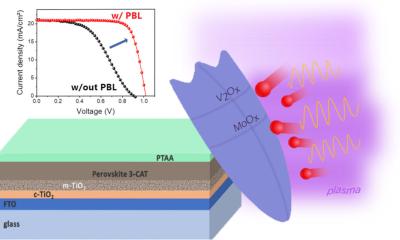Researchers from the University of Rome Tor Vergata, ENEA and CNR-ISM have used protective buffer layers in perovskite solar cells to mitigate damage during the sputtering of indium tin oxide in the production process. The scientists claim the buffer layers were able to achieve this without damaging the cell’s average visible transmittance.
The cell utilizes buffer layers made of transition metal oxides (TMOs) intended to protect the cell during the sputtering of indium tin oxide (ITO) in the cell production process. The scientists tested, in particular, two different evaporated transition metal oxides (TMOs) – molybdenum oxide (MoOx) and vanadium oxide (V2Ox) and found the former provided the best performance.
The buffer layer was tested in a cell built with a substrate made of glass and fluorine-doped tin oxide (FTO), an electron transport layer (ETL) based on carbon–titanium dioxide (C/TiO2) and a photocatalyst containing mesoporous titanium dioxide (m-TiO2). It also featured a perovskite absorber, a hole transport layer (HTL) made of poly-triarylamine (PTAA) and an indium tin oxide (ITO) electrode.
Through a series of tests, the research team found that the ITO sputtering affects the PTAA layer and its interfaces with the perovskite absorber and the ITO electrode, respectively.
"The ITO deposition process was optimized, balancing the UV plasma effect and the ion bombardment effect, and complete suppression of sputtering damage was achieved with the introduction of an evaporated TMO atop the PTAA layer,” the team said in the paper. “The use of ultrathin protective buffer layers (2.5 nm for V2Ox or 7.5 nm for MoOx) effectively mitigated the sputtering damage effects.”
The cell fabricated with the V2Ox buffer layer achieved an efficiency of 15.65% and that based on MoOx reached 16.44%.
“We successfully demonstrated that the protective buffer layer is effective at suppressing the sputtering damage also in thinner perovskite-based perovskite solar cells for BIPV application, without impairing the average visible transmittance (AVT),” the scientists said.


